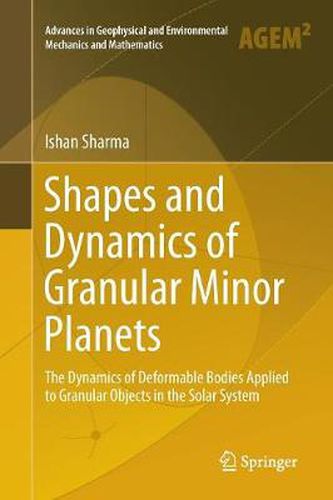Readings Newsletter
Become a Readings Member to make your shopping experience even easier.
Sign in or sign up for free!
You’re not far away from qualifying for FREE standard shipping within Australia
You’ve qualified for FREE standard shipping within Australia
The cart is loading…






This title is printed to order. This book may have been self-published. If so, we cannot guarantee the quality of the content. In the main most books will have gone through the editing process however some may not. We therefore suggest that you be aware of this before ordering this book. If in doubt check either the author or publisher’s details as we are unable to accept any returns unless they are faulty. Please contact us if you have any questions.
This book develops a general approach that can be systematically refined to investigate the statics and dynamics of deformable solid bodies. These methods are then employed to small bodies in the Solar System. With several space missions underway and more being planned, interest in our immediate neighbourhood is growing. In this spirit, this book investigates various phenomena encountered in planetary science, including disruptions during planetary fly-bys, equilibrium shapes and stability of small rubble bodies, and spin-driven shape changes.
The flexible procedure proposed here will help readers gain valuable insights into the mechanics of solar system bodies, while at the same time complementing numerical investigations. The technique itself is built upon the virial method successfully employed by Chandrasekhar (1969) to study the equilibrium shapes of spinning fluid objects. However, here Chandrasekhar’s approach is modified in order to study more complex dynamical situations and include objects of different rheologies, e.g., granular aggregates, or rubble piles . The book is largely self-contained, though some basic familiarity with continuum mechanics will be beneficial.
$9.00 standard shipping within Australia
FREE standard shipping within Australia for orders over $100.00
Express & International shipping calculated at checkout
This title is printed to order. This book may have been self-published. If so, we cannot guarantee the quality of the content. In the main most books will have gone through the editing process however some may not. We therefore suggest that you be aware of this before ordering this book. If in doubt check either the author or publisher’s details as we are unable to accept any returns unless they are faulty. Please contact us if you have any questions.
This book develops a general approach that can be systematically refined to investigate the statics and dynamics of deformable solid bodies. These methods are then employed to small bodies in the Solar System. With several space missions underway and more being planned, interest in our immediate neighbourhood is growing. In this spirit, this book investigates various phenomena encountered in planetary science, including disruptions during planetary fly-bys, equilibrium shapes and stability of small rubble bodies, and spin-driven shape changes.
The flexible procedure proposed here will help readers gain valuable insights into the mechanics of solar system bodies, while at the same time complementing numerical investigations. The technique itself is built upon the virial method successfully employed by Chandrasekhar (1969) to study the equilibrium shapes of spinning fluid objects. However, here Chandrasekhar’s approach is modified in order to study more complex dynamical situations and include objects of different rheologies, e.g., granular aggregates, or rubble piles . The book is largely self-contained, though some basic familiarity with continuum mechanics will be beneficial.